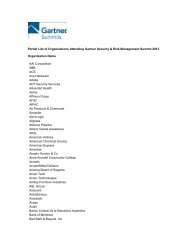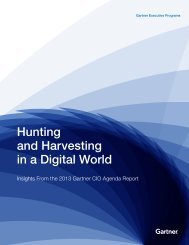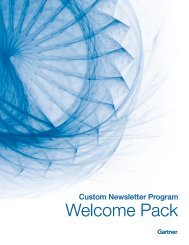SAMPLE SAMPLE - Gartner
SAMPLE SAMPLE - Gartner
SAMPLE SAMPLE - Gartner
Create successful ePaper yourself
Turn your PDF publications into a flip-book with our unique Google optimized e-Paper software.
Issue 1<br />
<strong>SAMPLE</strong><br />
Post-Composition: magic<br />
bullet for the new ADF<br />
<strong>SAMPLE</strong><br />
2<br />
4<br />
6<br />
8<br />
10<br />
11<br />
13<br />
16<br />
Issue 1<br />
Post Composition tools are becoming strategic to organizations<br />
Part 2 – Evolution of Post Composition Tools<br />
Part 3 – Remake as the solution to implement IMB<br />
Part 4 – Remake as the solution for Trans-Promo<br />
Part 5 – Improving operational eff iciency<br />
Part 6 – Remake as a key ADF component<br />
Cost Cutting in Production Print and Mail Operations<br />
About Sefas<br />
Featuring research from
2<br />
Post Composition tools are becoming strategic<br />
to organizations<br />
The ability to modify existing print streams and document applications “postcomposition”<br />
is not a particularly new concept, but it is one that has gained<br />
increased importance and popularity.<br />
The ability to enhance and make changes to enduring documents like statements,<br />
notifications and customer correspondence in the post-composition phase of<br />
production has become ever more strategically important. Specific drivers,<br />
like the imminent USPS conversion to Intelligent Mail Barcodes (IMB) and the<br />
popular adoption of “trans-promo” documents, have fueled revitalized interest in<br />
post-composition tools, while the need to optimize production with factory-like<br />
tracking and efficiency has brought document processing to new attention and strategic consideration.<br />
“By interfacing with<br />
our existing software,<br />
Open Print solution<br />
gave us the ability to<br />
quickly meet the needs<br />
of a demanding new<br />
project both in terms of<br />
presentational quality<br />
and ease of change.<br />
It has positioned us<br />
for the future and for<br />
taking on many more<br />
projects.<br />
Project Manager EDS-DWP<br />
”<br />
While post-composition tools with various and evolving capabilities have been on the market for<br />
several years, most are not fully deployed; application has typically been limited to rather constrained<br />
functionality or used to solve an isolated problem – swapping a barcode or adjusting an address block. The<br />
complexity of the tools and the resources needed to take advantage of the full benefits available made<br />
efforts simply more involved than most organizations were willing to tackle.<br />
But companies are now taking a broader look at post-composition tools like Open Print Remake – not<br />
only as vehicle to facilitate pragmatic modifications like IMB conversion, but also as a way to unleash<br />
new options to optimize the overall performance<br />
<strong>SAMPLE</strong><br />
and production of their mission-critical documents.<br />
Companies find that by using Remake they can improve efficiency, achieve cost reductions, and bring<br />
their document environment to the next level of Information Age performance in ways that were simply<br />
not possible in the past.<br />
In this newsletter, we will explore how post-composition tools, like Open Print Remake, are now seen as<br />
strategic for many initiatives and process improvement efforts. Here are a few to consider:<br />
IMB Conversion – Conversion to the new USPS Intelligent Mail Barcodes will be required in 2009 and<br />
is one clear example of how Sefas Remake can be a valuable and viable alternative to extensive and<br />
costly reprogramming.<br />
Trans-Promo – The industry is buzzing about “trans-promo” as a way to improve the relevance and<br />
effectiveness of customer statements. Remake gives companies the ability to create and execute<br />
common trans-promo applications rapidly, and without the need to redesign the document.<br />
Efficiency and Costs – Advancements in digital color printers and automated mail inserters give<br />
companies the ability to optimize production with factory-like efficiency. Remake unleashes these<br />
improvements and modifications with an increased level of post-composition capability and flexibility.<br />
Foundation for an ADF – Realizing the objective of an “Automated Document Factory” is no longer<br />
reserved only for organizations with a high level of funding, resources and determination. Companies of<br />
all types and sizes can leverage the post-composition capabilities of Remake is a foundation for an ADF.<br />
Open Print Remake – An Essential Component of your document production chain<br />
Many of our large customers, financial institutions and services bureaus have achieved a variety of efficiencies<br />
and savings using Remake and regard the post-composition capabilities they have gained as a key element<br />
of their document production chain. Their most critical applications go through our system and any time they
3<br />
want to make a change they have a singular point of control. They can change and enhance everything they<br />
produce without having to modify each and every application.<br />
We hope you find this newsletter to be an informative and useful resource as you explore how the<br />
post-composition capabilities of Open Print Remake can help bring about important capabilities and<br />
improvements for your organization.<br />
Jean-Philippe Sarraut<br />
CEO, Sefas Innovation<br />
<strong>SAMPLE</strong>
4<br />
Part 2 – Evolution of Post Composition Tools<br />
It used to be just heavy programming and<br />
scripting<br />
Most post-composition tools on the market<br />
are programming-intensive; you have to be a<br />
programmer to leverage the capabilities and<br />
you have to do a lot of coding to affect a change<br />
to an application. As a result, many customers<br />
initially turned away from early post-composition<br />
solutions due to the high level of skills and<br />
resources required. Other organizations found<br />
limited success because they could not reuse<br />
their application to process different types of jobs<br />
because their application was so dependent to the<br />
incoming data stream.<br />
Leading the way with an easy to use GUI as<br />
early as 2002<br />
In 2002, Sefas began to take post-composition<br />
functionality to a higher level in terms of easeof-use.<br />
We were the first company to introduce a<br />
graphical user interface (GUI) designed to easily<br />
perform the most complex types of document<br />
changes with limited use of scripting.<br />
Making important changes and enhancements<br />
using the Remake GUI is simple. You view the<br />
document, draw boxes to define the specific<br />
areas you want to work with, and then apply<br />
modifications that are independent of the original<br />
<strong>SAMPLE</strong> documents<br />
data streams. Since Remake is an object<br />
oriented tool, you can easily access and define the<br />
elements you need – page number, address block,<br />
barcode, account number, etc – and then create<br />
a variety of new conditions. Remake allows you<br />
to transform the enhanced documents into any<br />
common output format regardless of the initial<br />
data stream format.<br />
Remake makes post-composition changes<br />
easy.<br />
Here are just a few of the many possibilities:<br />
• Colorize your documents<br />
• Add marketing messages<br />
• Add Onserts to eliminate physical inserts<br />
• Add charts and graphics<br />
• Reposition data or address block<br />
• Add IMB Barcode<br />
• Replace OMR mark with 1D or 2D Barcodes<br />
• Convert from simplex to duplex<br />
• Transform data stream to individual PDF<br />
The ease-of-use with Remake is unmatched, and<br />
when combined with the ability to reuse common<br />
objects across all applications the tool provides<br />
you with a level of capability that was previously<br />
very difficult with other tools.<br />
Real time in One Conversion<br />
Remake Makes Post-Composition Changes Easy<br />
Source: Sefas
5<br />
The importance of data stream independence<br />
A number of industry standard data streams are at<br />
work in organizations today. The host of protocols<br />
– including AFP, Xerox LCDS and Metacode, PCL,<br />
PS, PDF and others – represent an alphabet soup<br />
of platforms from which to choose. Each has<br />
distinct characteristics and benefits for different<br />
types of applications. Data stream diversity has<br />
been a perennial stumbling block to document<br />
enhancement efforts since most of the tools on<br />
the market are not data stream independent<br />
and therefore prohibited meaningful progress for<br />
anything other than isolated applications.<br />
larger than the actual information to be mined in<br />
order to accommodate variations or future changes.<br />
The result: The exact location of an address block<br />
Remake provides a bridge across all applications<br />
by converting all the input data streams into the<br />
Sefas proprietary Virtual Page Format (VPF)<br />
regardless of input file type. This way, companies<br />
engage a single application that will work with<br />
all the various flavors of input they must manage.<br />
Data stream independence is important when<br />
enhancements involve many different applications<br />
across the enterprise. Consider, for example,<br />
the need to remove old OMR marks and replace<br />
them with a 2D barcode. This is a fairly common<br />
production upgrade, but working with multiple<br />
input files in multiple data formats can be time<br />
consuming and require specialized expertise<br />
and programming. With Remake, you can<br />
write a single application that will work with all<br />
the various input files, perform the 2D barcode<br />
replacement, and output the job into a common<br />
output for printing and electronic delivery.<br />
Data stream independence makes a Remake<br />
application reusable for many applications.<br />
The importance of data location independence<br />
Many companies live with the fear that if they<br />
change their document application, and data moves<br />
slightly, their post-composition modules will no<br />
longer function correctly. After all, with most postcomposition<br />
tools if the locations of an element like<br />
an address block, account number or tracking code<br />
varies by only a fraction of an inch the chances of<br />
something going wrong greatly increase. As a result,<br />
companies resist the use of post-composition tools<br />
and make costly changes to the application to avoid<br />
putting production at risk.<br />
A Remake application can be designed to work<br />
independently of the location of the data. The<br />
product looks for certain information in predefined<br />
areas on a page in either fixed or floatable<br />
positions. The defined areas can be created much<br />
or an account number can change slightly from one<br />
page to another, or from one source application to<br />
another, without causing the Remake application<br />
to fail. This makes your application more robust and<br />
less sensitive to any variation.<br />
The new version of Remake features greater<br />
ease of use – coming close to composition tools<br />
<strong>SAMPLE</strong><br />
At GraphExpo in Chicago during October 2008,<br />
Sefas is unveiling its latest version of Remake<br />
due for release in early 2009. This new version<br />
brings post-composition to a new level of ease<br />
of use by allowing users to make applications<br />
changes in no time. Sefas has worked diligently<br />
to bring key composition and post-composition<br />
capabilities together within Remake by<br />
leveraging many of the robust features found in<br />
MiddleOffice, the Sefas document composition<br />
platform. Like MiddleOffice, Remake is now<br />
a web-based tool that encourages true document<br />
collaboration by enabling users to access the tool<br />
in real time from any workstation connected to the<br />
Internet without installing any software on their<br />
workstation.<br />
Core to the new version of Remake is the use<br />
of a central repository that allows developers to<br />
store, manage, and re-use existing building blocks<br />
across applications. This encourages and enforces<br />
the use of standards, cuts development time,<br />
and facilitates the maintenance of applications.<br />
Corporate designers define standard templates<br />
used company wide, for example, while marketing<br />
professionals define strategic branding and<br />
marketing messages, and business users design<br />
documents using the dynamically changing<br />
elements.
6<br />
Since the tool is an object-orientated environment,<br />
and objects are reusable, Remake allows<br />
companies to create an object under centralized<br />
control – a barcode for example – and have that<br />
element available and deployed for all applications<br />
across the enterprise. At the same time, document<br />
designers and stakeholders have widely dispersed<br />
and easy accessibility to collaborate, modify and<br />
implement document changes and enhancements<br />
without the risk of causing difficulty with “locked<br />
down” production elements such as barcodes or<br />
address blocks.<br />
This new version of Remake allows companies to<br />
better manage their enhancement objects, define<br />
document presentation standards, and dramatically<br />
reduce development time.<br />
Enterprise class architecture<br />
Now that companies use post-composition as a core<br />
component of their document production workflow,<br />
any tool or solution must meet the most demanding<br />
architectural requirements in terms of platforms,<br />
scalability and security. Thanks to its commitment<br />
to enterprise-class products, The design<br />
environment can run on any server and utilizes a<br />
<strong>SAMPLE</strong><br />
JDBC compliant database. Security is provided by<br />
LDAP access. The production engines are available<br />
on all the most common platforms. These include<br />
Z/OS or Z/Linux on mainframes, and virtually any<br />
flavor of Unix including AIX, Sun Solaris, HP-UX<br />
and Linux as well as Windows. From the scalability<br />
point of view, Remake was designed to handle the<br />
highest volumes in the industry and take advantage<br />
of horizontal and vertical scaling methods to<br />
process in excess of 50,000 pages per minute.<br />
Our largest customers rely on Remake to process<br />
all their mission critical documents produced in<br />
their print and mail operations. As a result, IT<br />
directors and decision-makers are becoming more<br />
and more involved with the systems and processes<br />
involved with document production. After all,<br />
documents are a key component to doing business,<br />
and developing factors like IMB, trans-promo and<br />
ADF-like optimization are driving a higher level<br />
of involvement and focus on document systems.<br />
Document production is now considered a critical<br />
function that must be monitored and optimized or<br />
the company will be exposed to increased expense<br />
and risk.<br />
Source: Sefas<br />
Part 3 – Remake as the solution to implement IMB<br />
Solving the IMB challenge<br />
Conversion to the upcoming USPS Intelligent<br />
Mail Barcode is one clear example of how a postcomposition<br />
tool like Open Print Remake can be<br />
valuable. The new IMB will soon be required for<br />
organizations in order to retain eligibility for high<br />
volume mailing discounts. Companies without a<br />
migration strategy risk serious financial impact;<br />
postal discounts can mean millions of dollars<br />
saved in mailing expense and organizations that<br />
fall behind may pay a high price.<br />
Implementing IMB across multiple applications<br />
can be a complex endeavor. The scope of the<br />
effort literally touches all applications across<br />
the enterprise. Regardless of whether they<br />
come from a legacy application or another<br />
document composition environment, each<br />
individual application requires modification. As<br />
a result, without a post-composition tool, the<br />
task of implementing IMB requires extensive<br />
reprogramming and may likely encompass many<br />
different jobs and thousands of lines of code.<br />
Multiply this complexity across all the various lines<br />
of business and applications, and the cost, effort<br />
and expertise needed to implement IMB is very<br />
high indeed.<br />
Companies find that implementing IMB is best<br />
done in the post-composition phase. For example,<br />
Remake can easily remove older Postnet<br />
barcodes from your legacy documents and replace<br />
them with the new IMB. In one conversion effort<br />
completes the migration to the new USPS standard<br />
and ensures optimal postal discounts across all the<br />
documents. Since the jobs are centralized via one<br />
point of conversion there is no need to reprogram<br />
all applications – Remake automatically makes<br />
the necessary changes.
7<br />
Real time in One Conversion<br />
Real-time in One Conversion Tool<br />
Source: Sefas<br />
The opportunities beyond IMB<br />
While IMB conversion may seem somewhat<br />
compulsory, it is also an excellent opportunity<br />
to enhance and optimize your document<br />
production environment. First is the opportunity<br />
to “normalize” your output in ways that can save<br />
money and build systemic efficiency. For example,<br />
with Remake, an address block is a standard<br />
object that is tied across all the documents and<br />
platforms. This ensures a standardized placement<br />
for all your applications. Another opportunity is<br />
tracking; Remake can implement an integrity<br />
barcode – 1D, 2D or even use the IMB – to<br />
establish a unique document tracking number and<br />
allow your operations to monitor the location and<br />
status of each document being processed. With<br />
Open Print Delivery you can also interface with<br />
address preparation software (CASS, PAVE, NCOA)<br />
to cleanse mailing addresses and reduce the<br />
impact of undeliverable mail.<br />
Companies that take advantage of the opportunity<br />
to optimize their existing print streams can find<br />
further automated mail processing improvement<br />
via “house-holding” – the act of delivering<br />
different documents intended for the same<br />
household in a common envelope. House-holding<br />
allows you to dramatically reduce mailing costs<br />
because you are mailing a fewer number of mail<br />
pieces to the same address. When you consider<br />
that the cost of each finished mail piece is about<br />
50 cents (postage, paper, envelopes, etc), householding<br />
can have a huge impact on the bottom<br />
<strong>SAMPLE</strong><br />
line.<br />
Electronic comingling is another opportunity to<br />
bring about additional savings and efficiencies,<br />
plus leverage investments in printing technology.<br />
Job merging, often used in combination with a<br />
postal presort package (PAVE), greatly enhances<br />
efficiency by comingling once disparate production<br />
jobs together according to the sequences and<br />
batches that will make best use of your production<br />
equipment. Rather than singular printing and<br />
mailing runs, jobs from different applications and<br />
customer segments are merged and sorted to<br />
facilitate the best and most efficient production.<br />
High speed, digital color printers are maximized<br />
in terms of their flexibility and speed. Automated<br />
inserters and sorters are leveraged for maximum<br />
processing efficiency and to reach higher Zip<br />
Code concentrations. Addresses are cleansed and<br />
updated to ensure the most accurate processing.<br />
Through it all, Remake makes sure that the<br />
inserter marks and integrity barcodes are properly<br />
generated for each output run regardless of the<br />
sort scheme.<br />
Source: Sefas
8<br />
Part 4 – Remake as the solution for Trans-Promo<br />
The challenges of trans-promo<br />
“Trans-promo” is an approach that mixes<br />
transactional printing with digital color output and<br />
variable marketing data with the aim to improve<br />
the relevance and effectiveness of bills, account<br />
summaries and customer statements. Until<br />
recently, companies typically approached transpromo<br />
efforts at the document composition phase,<br />
electing to build new applications from the ground<br />
up. While there are advantages to this from-scratch<br />
approach, the problem is that the process can take<br />
forever to complete. For whatever reason – lack<br />
of tools, lack of resources, lack of personnel and<br />
skills – designing trans-promo documents at<br />
the document composition stage can often be a<br />
prohibitively long and laborious process. By the<br />
time all the pieces are in alignment, months, or<br />
even years, can pass before the effort is complete.<br />
Remake is a tool that allows you to create and<br />
deploy trans-promo documents more easily across<br />
all your various enterprise applications since it<br />
was engineered to create and execute common<br />
trans-promo applications rapidly, and without the<br />
need to redesign the document or reprogram the<br />
source code. In our experience, even our customers<br />
with existing and robust composition tools see<br />
the value of Remake; often as the first tool<br />
they reach for to make important changes while<br />
acknowledging that their long term objectives<br />
point to eventual large scale deployment via a<br />
formal document composition tool like Open Print<br />
MiddleOffice.<br />
<strong>SAMPLE</strong><br />
Effectively managing the many different types<br />
of messages, facilitating which messages will be<br />
sent to which recipients, and tracking ongoing<br />
promotional activities requires a sophisticated<br />
and intelligent linkage within the printing and<br />
mailing process that is often lacking. Companies<br />
can overcome this gap by using Remake to<br />
interface directly with campaign management<br />
tools. For instance, Remake can check a<br />
table, follow the business rules associated with<br />
each message, manage the white space, and<br />
automatically implement trans-promotional<br />
messages accordingly. The system helps keep<br />
track of ongoing campaign efforts across all the<br />
applications as each document is processed.<br />
Key product features<br />
Remake has a number of key product features<br />
that are tailored to support trans-promo<br />
documents. Whether you need to revitalize<br />
your documents by adding color or customized<br />
marketing messages, or you need to solve address<br />
quality and document integrity issues, Remake<br />
enables you to rapidly implement changes that<br />
will improve the effectiveness of your documents.<br />
Replace company logo – Remake can<br />
easily replace logos or images, change a<br />
letterhead, or add a wide range of full color<br />
graphics and elements. Specific business rules<br />
can be applied to any page or component of a<br />
page. Since Remake allows you to create a<br />
color image for web presentment you can also<br />
Key Product Features for Trans-Promo Messages<br />
Source: Sefas
9<br />
Adding Barcodes, Color and Value<br />
Source: Sefas<br />
leverage your existing print streams for online<br />
delivery.<br />
Add color – Research is clear: Color documents<br />
get more attention. Remake helps you build<br />
the marketing value of your legacy documents<br />
by colorizing monochrome production jobs<br />
without the need for reprogramming. Now you<br />
can truly eliminate your pre-printed forms and<br />
special stock while taking advantage of the<br />
flexibility of digital color output.<br />
Manage white space – White space is an<br />
often overlooked aspect that can provide a<br />
number of opportunities for improvement. An<br />
over abundance of white space can result in<br />
increased page counts and heavier mail pieces.<br />
On the other hand, using available white space<br />
for customized trans-promo messages can help<br />
with cross-selling and customer satisfaction.<br />
Remake enables thoughtful strategies<br />
regarding the use of white space that can often<br />
result in undiscovered savings and advantages.<br />
inserts by virtue of on-statement inserts, or<br />
“Onserts.” The system will calculate how many<br />
more pages can be added to reach the next<br />
postal weight, and fill the available envelope<br />
space with Onserts, coupons, and offers of<br />
different sizes and types based on business rules.<br />
<strong>SAMPLE</strong><br />
Track messages<br />
– Once you insert custom<br />
messages and Onserts,<br />
Remake will create a<br />
database file that tracks<br />
which messages have<br />
been sent, to which<br />
recipient, and when. With<br />
the ability to track what<br />
has been sent companies<br />
not only maximize their<br />
promotional efforts but<br />
they also significantly<br />
reduce the number of<br />
errors and redundancy in<br />
the process overall.<br />
Creating a Trans-Promo Document<br />
Access external tables –Remake can<br />
easily add targeted marketing messages to<br />
your existing transactional documents by<br />
accessing external campaign management<br />
tables. Remake will determine how much<br />
white space is available on the page then<br />
access external files that store the customized<br />
messages and business rules that determine<br />
which message(s) should be included in which<br />
document.<br />
“Onserts” – Remake can reduce the expense<br />
and labor associated with traditional mailing<br />
Leverage color printer<br />
capabilities – The cost of<br />
full color digital printing<br />
Source: Sefas<br />
equipment has become<br />
more and more affordable,<br />
and color is now a must-have for modern transpromo<br />
documents. But moving from monochrome<br />
to color with legacy print streams can be costly<br />
and time consuming. Companies are often slow to<br />
make the most of their new hardware investments<br />
as a result. Remake easily repurposes your<br />
legacy applications with color to take advantage of<br />
the latest printing technology.
10<br />
As we have seen, post-composition is often the<br />
best, if not the only, place in the document<br />
production chain to effectively implement these<br />
kinds of trans-promo focused improvements.<br />
Remake helps you revitalize your documents<br />
by adding targeted content, digital color and<br />
customized Onserts. The result is that each<br />
document is significantly more relevant and<br />
compelling to each of your customers. The process<br />
is centralized, so Remake affects modifications<br />
and enhancements to all the required applications<br />
regardless of the system or format where they<br />
originated. Remake allows you to make<br />
improvements easily and rapidly by putting you in<br />
post-composition control.<br />
Source: Sefas<br />
Part 5 – Improving operational efficiency<br />
Many companies miss important cost-cutting<br />
opportunities because printing and mailing<br />
operations often function in an isolated fashion.<br />
The prevailing focus is often limited to getting<br />
documents out of print queue or moved off of<br />
the loading dock. This “over-the-wall” approach<br />
does not encourage operational efficiency and<br />
collaboration. Mailing systems managers typically<br />
have no control over print data streams, and<br />
information systems administrators have little<br />
empathy for the intricacies of automated mailing.<br />
Remake is a tool that can help overcome these<br />
obstacles by providing effective and realistic<br />
system improvements that bridge the functional<br />
gap. Here are just a few examples:<br />
Concatenate small jobs – Small jobs<br />
cause printers to start and stop, dramatically<br />
reduces the throughput on mail inserters, and<br />
complicates the mail piece tracking process.<br />
Remake allows you to group multiple jobs<br />
into a single stream for greater processing<br />
efficiency. Banner pages of existing jobs can be<br />
kept or eliminated, and a new banner page for<br />
the entire set can be created. Integrity marks<br />
and intelligent insertion files can be generated<br />
and added to the entire set.<br />
Split large jobs – Splitting large jobs allows<br />
operations to better balance the workload<br />
between printers and inserters and maximize<br />
their overall production throughput. Remake<br />
can split jobs using a variety of criteria; you can<br />
segment print jobs by the number of pages, the<br />
number of documents, or any combination of<br />
parameters with confidence and flexibility. The<br />
system will make sure that the inserter marks<br />
and integrity barcodes are properly generated for<br />
each output run regardless of the sort scheme.<br />
<strong>SAMPLE</strong><br />
Simplex to duplex – Many companies still<br />
print high volume applications in simplex.<br />
Moving from simplex to duplex, or double-sided,<br />
printing will lower page counts, cut paper and<br />
envelope costs, shorten printing and insertion<br />
run times, and achieve dramatic postage savings.<br />
Remake easily converts simplex documents to<br />
duplex without the need for original application<br />
reprogramming. Pre-printed boilerplate can be<br />
inserted anywhere in the document, pages can<br />
be re-numbered, and all the insertion control<br />
marks can be updated automatically.<br />
Relocate address block to use common<br />
envelope – Remake can reposition an<br />
address block from anywhere on a document<br />
and ensure that it is positioned in a consistent<br />
and standard location. This allows you to<br />
reduce the number of envelopes and forms you<br />
purchase, store and manage. Companies trim<br />
overhead costs by eliminating unnecessary<br />
inventory and by taking advantage of higher<br />
volume discounts, and increase operational<br />
efficiency by standardizing and automating the<br />
print/mail process.<br />
Move from cut-sheet to continuous feed – Volume<br />
growth and advancements in high speed printers<br />
have prompted many organizations to move<br />
from cut-sheet printing to a continuous or “rollfeed”<br />
printing environment. Remake makes the<br />
transition easy without the need to reprogram<br />
legacy applications or redesign the application<br />
using a document composition tool. As a result,<br />
companies save money on paper and more quickly<br />
leverage their investments in new hardware and<br />
technology.<br />
Source: Sefas
11<br />
Success story<br />
Citizens Financial Group recently relied on<br />
Remake as a key component of efforts to<br />
consolidate all of its printing and mailing activities<br />
in a facility located in Riverside, RI. The center,<br />
which is equipped with the latest IBM continuous<br />
printers and Kern inserters, produces more than 95<br />
million statements and over 300 million images<br />
per year. Citizens realized that consolidating the<br />
print and mail production to a single production<br />
center and updating the printer and inserter<br />
hardware in the mailroom would require that<br />
their entire document production process be<br />
re-engineered. Duplex conversion, statement<br />
integrity and address quality were on the short list<br />
of immediate needs, while multi-channel delivery<br />
and ADF efficiencies were long-term goals.<br />
In the end, Citizens Financial Group selected<br />
Remake to enable a variety of post-composition<br />
modifications and enhancements, and the results<br />
have been impressive. Duplex conversion has<br />
resulted in $2.1 million per year in savings to the<br />
bank in postage alone. In parallel, there was a<br />
25% - 30% decrease in paper utilization. Overall,<br />
Citizens has seen over $3 million per year in<br />
readily identifiable savings using Remake.<br />
<strong>SAMPLE</strong><br />
Source: Sefas<br />
Part 6 – Remake as a key ADF component<br />
“We realized that as<br />
part of our efforts to<br />
improve the business<br />
process, we needed<br />
to move into the<br />
new age of print and<br />
mail. We needed to<br />
implement techniques<br />
for ADF (Automated<br />
Document Factory) to<br />
reduce costs, improve<br />
statement integrity,<br />
and address quality.<br />
We also wanted a way<br />
to get a quick hit on<br />
postal cost reductions.<br />
Citizens Bank<br />
”<br />
State-of-the-art document processing takes form in<br />
the notion of an “Automated Document Factory.”<br />
For most organizations, however, factory-like<br />
efficiency and piece-level tracking is elusive; true<br />
automation has generally been achieved only by<br />
those organizations with a significantly high level<br />
of funding, expertise and commitment. Remake<br />
changes all that by providing a centralized<br />
and flexible post-composition tool that is easy<br />
to use and cost effective to own. Remake in<br />
combination with Open Print Delivery and<br />
producer allows you to easily implement<br />
features such as piece level tracking, house<br />
holding, job sorting and merging, and a variety<br />
of print/mail production enhancements that<br />
would otherwise require hours of recoding and<br />
specialized programming expertise. Companies<br />
look to Remake as an essential tool to drive an<br />
ADF, optimize production and build higher levels of<br />
efficiency.<br />
Document integrity – Despite all of the tools<br />
and systems available today, many companies<br />
continue to struggle with document integrity.<br />
And with increasingly strict regulations<br />
regarding sensitive information, and mounting<br />
pressure from privacy advocates and customers<br />
alike, companies need “zero-defect” document
12<br />
integrity. Remake boosts integrity by<br />
adding intelligent barcodes, for example, that<br />
uniquely identifies every document. This allows<br />
companies to readily locate and track every<br />
piece, and guarantee that every document has<br />
been produced and delivered correctly.<br />
Document tracking – Document tracking<br />
is essential for any ADF, but fully integrated<br />
tracking has been elusive and complex due<br />
to the various suppliers and isolated systems<br />
found in large scale printing and mailing<br />
operations. The conversion to the mandatory<br />
USPS Intelligent Mail Barcode, however,<br />
provides a great opportunity to overcome this<br />
barrier. Remake can include tracking fields<br />
within an IMB that will locate documents<br />
where ever they exist within your ADF and<br />
beyond through the postal system. Remake<br />
can also simply assign a unique document<br />
tracking number to each document and add it<br />
in the integrity barcode. This will enable the<br />
operator to simply scan the barcode to find,<br />
view and reprint any document produced.<br />
Creation of intelligent data files – Remake<br />
was designed to extract fields from legacy<br />
print streams and calculate variables to create<br />
intelligent insertion files. The system supports<br />
all the formats from all the inserter vendors<br />
such as HAL, MRDF and KIC. At the end of an<br />
insertion run, the data file is updated and any<br />
reprints are automatically requested.<br />
Automated reprints – Reprints are a costly<br />
and time-consuming task for most print and<br />
mail operations. The process often requires<br />
multiple levels of support to re-process<br />
the original documents. By enabling the<br />
automation of the entire reprint process,<br />
Remake provides tremendous operational<br />
savings with minimal human intervention.<br />
The importance of data streams normalization<br />
With a growing number of applications creating<br />
documents and different types of data-streams to<br />
process, it becomes increasingly important to be<br />
able to apply common function such as: adding an<br />
integrity barcode, correct the address, house-hold<br />
documents to all the documents and optimize<br />
these various data-streams by merging, sorting<br />
and splitting them into right-sized output streams.<br />
<strong>SAMPLE</strong><br />
All these function are enabled by converting all<br />
the data-streams into a common, normalized, and<br />
page independent format that can be manipulated<br />
and optimized. The Sefas Open Print product suite<br />
uses the Sefas proprietary Virtual Page Format<br />
(VPF) that is at the heart of the product suite. All<br />
the jobs processed by either MiddleOffice and<br />
FrontOffice, the document composition tools,<br />
and by Remake are converted to VPF and can<br />
therefore be enhanced and optimized.<br />
Remake puts a truly Automated Document<br />
Factory within reach by providing a level of process<br />
optimization that was previously very difficult and<br />
expensive to achieve.<br />
Companies more quickly and completely realize<br />
the benefits of their improvement efforts as a<br />
result. The ease-of-use and flexibility provided<br />
by Remake help companies make the best use<br />
of their printing and mailing infrastructure and<br />
unleash capabilities and enhancements that<br />
produce significant efficiencies and savings.<br />
Source: Sefas
13<br />
Research from <strong>Gartner</strong><br />
Cost Cutting in Production Print and Mail Operations<br />
Production print and mail operations have<br />
significant postage, paper and labor costs.<br />
Productivity improvements are the quickest<br />
and lowest-cost methods that operations<br />
managers have for generating near-term yet<br />
long-lasting cost savings.<br />
Key Findings<br />
• Productivity improvements reduce production<br />
print and mail labor costs by 10% to 15%.<br />
• Many cost-saving productivity improvements<br />
require little or no capital spending.<br />
• Indirect labor productivity improvements are<br />
just as important and valuable as direct labor<br />
cost reductions.<br />
Recommendations<br />
• Implement immediate and actionable<br />
productivity improvements spanning the<br />
complete workflow from warehouse to mailing.<br />
• Involve production staff in finding and<br />
implementing productivity improvement<br />
opportunities so cost reductions will remain in<br />
place for the long term.<br />
ANALYSIS<br />
Productivity improvements directly reduce<br />
production print and mail labor costs. The job<br />
mix and volumes vary, but the opportunity to cut<br />
costs immediately is present in every production<br />
print and mail operation. More importantly,<br />
these initiatives are under the direct control of<br />
operations management, which can implement<br />
them with little or no capital investment.<br />
Although labor is a smaller component of a<br />
mailing’s overall cost than postage, implementing<br />
process changes are instantaneous when compared<br />
with the time required to reduce the amount paid<br />
to the post office. Paper and envelope savings can<br />
take months to implement, given the need for prior<br />
approvals from marketing and procurement, as<br />
well as depleting the existing inventory.<br />
While prudent hardware and software investments<br />
will lower costs, productivity improvements do not<br />
necessarily require capital investments. Production<br />
print and mail operations managers will find the<br />
following $200,000 in process improvements can<br />
be swiftly implemented and result in significant<br />
savings at low or no cost. Every operation’s cost<br />
structure is different, so the actual savings may<br />
vary (see Note 1 for cost assumptions). The savings<br />
estimates refer to direct and indirect labor only,<br />
and do not account for quality improvement<br />
benefits:<br />
• Inside delivery of supplies – With appropriate<br />
security considerations in mind, truck drivers<br />
can deliver the materials directly to the<br />
warehouse or your print room instead of leaving<br />
the items on the dock. The time saved by your<br />
warehouse personnel can be put to uses that<br />
are more productive.<br />
• Potential annualized savings – $7,500<br />
(0.5%)<br />
• One-time cost to implement – None<br />
(may require negotiations with suppliers)<br />
• Raw material deliveries three times per week<br />
– Infrequent deliveries are only efficient for<br />
the supplier and trucker, not the print and mail<br />
operation. Frequent, albeit smaller, deliveries<br />
result in fewer stock outages (particularly if<br />
defective materials were received) and lost<br />
productivity.<br />
• Potential annualized savings – $4,400<br />
(0.3%)<br />
• One-time cost to implement – None<br />
(may require negotiations with supplier)<br />
<strong>SAMPLE</strong><br />
• Relocation of roll stock storage from warehouse<br />
to print area – Why put 50-inch rolls of paper<br />
into the warehouse and then move them again<br />
Upon delivery, line up the inventory directly<br />
in front of the printers that will use the stock.<br />
Not only does this eliminate a move your<br />
warehouse staff have to make, but when printer<br />
operators finish a roll or have to take one off<br />
because of a defect, they do not have to wait<br />
for new paper to be delivered.<br />
• Potential annualized savings – $14,100<br />
(0.9%)<br />
• One-time cost to implement – None<br />
(if current facility design allows) or low<br />
(if equipment must be moved or a wall<br />
knocked down)<br />
• Begin printer shift on Sunday night – Most<br />
applications batch data after the business day<br />
has ended, typically becoming available to print
14<br />
Note 1 Cost Assumptions<br />
The following assumptions were used for<br />
calculating cost savings:<br />
• There are 30 staff personnel.<br />
• Wages and benefits amount to $25 per<br />
hour (approximately $50,000 annually per<br />
employee).<br />
• Overhead (building, utilities, burden from<br />
corporate departments, and so on) is not<br />
included.<br />
• Raw materials are received from the three<br />
different suppliers (paper, envelopes and<br />
marketing inserts) twice per month and<br />
warehoused in a separate part of the facility.<br />
• There are three traditional shifts per day<br />
beginning at 7:00 a.m. Monday and running<br />
through 7:00 a.m. Saturday.<br />
• 200 jobs run each day for five days per<br />
week.<br />
• 52 weeks less 10 paid holidays are<br />
available for production.<br />
• Of the 200 jobs, 50 run on two continuous<br />
printers and 150 on two sheetfed printers.<br />
• Of the 200 jobs, 50 run on one flat-mail<br />
inserter and 150 on three folded-mail<br />
inserters (50 are half-fold and 100 are<br />
trifold mailings).<br />
• Each machine has an operator assigned<br />
to it every shift; each shift has quality<br />
assurance and one warehouse worker (10<br />
people per shift).<br />
• Equipment manufacturer provides<br />
maintenance with technicians and basic<br />
parts on-site.<br />
• Each job is analyzed by postal software<br />
and optimally sorted for that job alone.<br />
• Mail is sent to the post office twice daily.<br />
in the early morning hours. Starting the printer<br />
shift on Sunday night enables operators to<br />
have enough work produced before the inserter<br />
operators begin their day that the inserters can<br />
begin immediate production. The earlier start<br />
also provides more time to recover from printer<br />
problems.<br />
• Potential annualized savings – $18,800<br />
(1.3%)<br />
• One-time cost to implement – None<br />
(may require slight increase in shift<br />
premium paid to operators)<br />
• Begin warehouse shift one hour early – The<br />
key to smooth, continuous printer and inserter<br />
operation is to have sufficient materials at<br />
every workstation all the time. Warehouse<br />
people who start the day an hour earlier than<br />
the other operators on their shift do ensure the<br />
needed materials are in place for an immediate,<br />
productive startup.<br />
• Potential annualized savings – $18,800<br />
(1.3%)<br />
• One-time cost to implement – None<br />
• Begin each shift 10 minutes before the prior<br />
one ends – Little cross-shift communication<br />
can occur when operators meet at the door,<br />
one on the way in and one on the way out.<br />
Starting a shift 10 minutes “early” enables a<br />
conversation to occur about how the current job<br />
<strong>SAMPLE</strong><br />
is running, what jobs are coming up, whether<br />
maintenance or other support is needed, and so<br />
forth. This schedule means one or more breaks<br />
must be extended to keep the same number of<br />
hours per shift.<br />
• Potential annualized savings – $14,100<br />
(0.9%)<br />
• One-time cost to implement – None<br />
• Cover printers and inserters during operator<br />
breaks – Many companies do this when a<br />
big job is running or a delivery deadline is in<br />
jeopardy. However, regularly keeping as many<br />
printers and inserters operating as possible<br />
minimizes the need for additional equipment<br />
purchases while reducing the need for operator<br />
overtime.<br />
• Potential annualized savings – $50,000<br />
(3.3%)<br />
• One-time cost to implement – None<br />
• Schedule printers and inserters based on<br />
materials – Too often, frankly, operators choose<br />
the jobs they like to run and not the ones<br />
that make the most sense from a productivity<br />
perspective. Set up production schedules based<br />
on the materials needed to run on the prior and<br />
subsequent jobs to minimize printer or inserter<br />
changeover times.<br />
• Potential annualized savings – $12,500<br />
(0.8%)
15<br />
• One-time cost to implement – None<br />
• Replenish low-volume items in the warehouse<br />
– Warehouse personnel that carry one or two<br />
boxes of material out to the floor are wasting<br />
significant amounts of time. Use rolling carts to<br />
hold the low-volume items that do not warrant<br />
putting a pallet on the production floor. One<br />
cart can be replenished in the warehouse and<br />
delivered to the printer or inserter, and the<br />
depleted cart already at the machine can be<br />
rolled back to be efficiently refilled.<br />
• Potential annualized savings – $16,900<br />
(1.1%)<br />
• One-time cost to implement – None or<br />
very low (if carts must be purchased)<br />
• Implement “machine status” lights – Certain<br />
printers already come with this feature, which<br />
is basically a pole above the machine with<br />
green, yellow and red lights. When all is<br />
well, the green light is lit; when the machine<br />
is paused, yellow is lit; when the operator<br />
needs assistance, red lights up. This feature<br />
enables service technicians and managers to<br />
look across the production area and see the<br />
status of each machine and whether any need<br />
immediate assistance. If your facility is large<br />
enough, enhance the concept by transmitting a<br />
wireless signal to the technicians whenever red<br />
is lit. Regardless of the approach, the result is<br />
quicker response time, less machine downtime<br />
and improved productivity.<br />
• Potential annualized savings – $6,600<br />
(0.4%)<br />
• One-time cost to implement – Low (cost<br />
of purchasing and wiring lights)<br />
• Increase number and type of parts stored onsite<br />
– Neither you nor your suppliers benefit<br />
when machines are down waiting for parts<br />
to be delivered. Regularly review the parts<br />
stored on-site and determine the appropriate<br />
quantities based on both past usage and the<br />
effect aging has on the equipment to add more<br />
units or items. The potential labor savings are<br />
minimal compared with the cost of missed<br />
delivery deadlines and overtime pay resulting<br />
from machine shutdowns while waiting for<br />
parts to be delivered.<br />
• Potential annualized savings – $3,100<br />
(0.2%)<br />
• One-time cost to implement – None<br />
(may require coordination with suppliers)<br />
• Adhere to preventive maintenance (PM)<br />
schedules – Many operations view “PMs”<br />
as a necessary evil, when in fact they are<br />
a necessary benefit. Set up a PM schedule<br />
and adhere to it. The schedule must take<br />
into account anticipated workloads, such as<br />
quarterly reports, that not only will shift the<br />
time when the PM takes place but also dictate<br />
the equipment be ready to run virtually nonstop<br />
during the peak periods. Adhering to a PM<br />
schedule is easier said than done for many<br />
companies. If yours is one of them, consider<br />
scheduling the work during nonoperational<br />
hours, including weekends. The technicians<br />
may not like the hours, but the uninterrupted<br />
time will make them more efficient.<br />
• Potential annualized savings – $21,900<br />
(1.5%)<br />
• One-time cost to implement – None<br />
(may require negotiations with suppliers)<br />
• Supervisor, service and quality assurance offices<br />
on the production floor – Too often managers’,<br />
maintenance personnel’s and quality assurance<br />
staff’s offices are off the production floor,<br />
on the sidelines if you will. But every one of<br />
these people needs to be on the floor with the<br />
operators, facilitating work and ensuring the<br />
output meets or exceeds your expectations.<br />
The time lost while your operators look for the<br />
support personnel they need to troubleshoot<br />
a problem or answer a question reduces your<br />
operation’s productivity.<br />
• Potential annualized savings – $10,900<br />
(0.7%)<br />
• One-time cost to implement – Low<br />
(requires relocating offices and possible<br />
change of plant layout)<br />
<strong>SAMPLE</strong><br />
These productivity improvements may be the<br />
tip of the iceberg for your operation, or you may<br />
have already implemented a few. Regardless,<br />
immediate productivity improvements are within<br />
your span of control and, when the staff is involved<br />
from the beginning and throughout a continuous<br />
improvement process, will result in significant,<br />
immediate cost reductions. Regardless of your<br />
operation’s situation, make the time within the<br />
next month to sit down with your operators to<br />
begin a process of continually evaluating, testing,<br />
implementing and documenting cost-saving<br />
productivity improvements.<br />
<strong>Gartner</strong> RAS Core Research Note G00155374, Pete Basiliere,<br />
3 March 2008
16<br />
About Sefas…<br />
Sefas Innovation is a world leader in document production technology.<br />
The company is headquartered in Paris, France, with operations in the<br />
U.S. and the U.K. Sefas has been a leader in the European market since<br />
1993 and has created expert enterprise solutions with unparalleled<br />
levels of flexibility and performance.<br />
Many of the largest financial companies and Fortune 500 leaders rely<br />
on our technology to produce complex, high-volume and mission<br />
critical transactional documents.<br />
About our technology…<br />
Our Open Print product suite is based on a three-tier client-server architecture that is easy to deploy<br />
throughout your enterprise and scale to accommodate very high production volumes. Our technology<br />
accommodates a comprehensive variety of platforms, including Windows, z/OS and UNIX.<br />
We were the first document production vendor to run in an IBM grid clustering environment.<br />
Our design environment is built around a central repository that allows any document stakeholder to<br />
share resources in real-time, regardless<br />
<strong>SAMPLE</strong><br />
of location. We separate data from design, and design from output.<br />
This provides the flexibility to use any type and number of data files in the design process and to render<br />
documents in any possible output format. Sefas leads the document industry in performance, flexibility<br />
and scalability.<br />
Whether your documents are printed on paper or sent electronically, Sefas delivers.<br />
Post-Composition: magic bullet for the new ADF is published by Sefas. Editorial supplied by Sefas is independent of <strong>Gartner</strong> analysis. All <strong>Gartner</strong> research is © 2007 by <strong>Gartner</strong>,<br />
Inc. and/or its Affiliates. All rights reserved. All <strong>Gartner</strong> materials are used with <strong>Gartner</strong>’s permission and in no way does the use or publication of <strong>Gartner</strong> research indicate<br />
<strong>Gartner</strong>’s endorsement of Sefas’ products and/or strategies. Reproduction and distribution of this publication in any form without prior written permission is forbidden. The<br />
information contained herein has been obtained from sources believed to be reliable. <strong>Gartner</strong> disclaims all warranties as to the accuracy, completeness or adequacy of such<br />
information. <strong>Gartner</strong> shall have no liability for errors, omissions or inadequacies in the information contained herein or for interpretations thereof. The reader assumes sole<br />
responsibility for the selection of these materials to achieve its intended results. The opinions expressed herein are subject to change without notice.
















